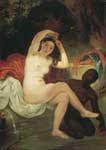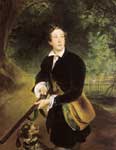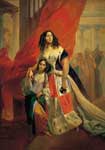Artist Index
A - B - C - D - E - F - G - H - I - J - K - L - M
N - O - P - Q - R - S - T - U - V - W - X - Y - Z
Paintings

Bathsheba

Hope feeding love

Morning In Italy,

Portrait Aurora Demidova , Karamzina

Portrait of Aleksey Konstantinovich Tolstoy

Portrait of Countess Yulia Samoilova

Portrait of Sophia Shuvalova
Karl Pavlovich Briullov (Russian: Карл Павлович Брюллов), called by his friends the Great Karl (12 December 1799 – 11 June 1852) was a Russian painter. He is regarded as a key figure in transition from the Russian neoclassicism to romanticism.
Biography
Born of French parents in Saint Petersburg, Carlo Brulleau (as his name was spelled until 1822) felt drawn to Italy from his early years. Despite his education at the Imperial Academy of Arts (1809–1821), Briullov never fully embraced the classical style taught by his mentors and promoted by his brother, Alexander Briullov. After distinguishing himself as a promising and imaginative student and finishing his education, he left Russia for Rome where he worked until 1835 as a portraitist and genre painter, though his fame as an artist came when he began doing historical painting.
His best-known work, The Last Day of Pompeii (1830–1833), is a vast composition compared by Pushkin and Gogol to the best works of Rubens and Van Dyck. It created a sensation in Italy and established Briullov as one of the finest European painters of his day. After completing this work, he triumphantly returned to the Russian capital, where he made many friends among the aristocracy and intellectual elite and obtained a high post in the Imperial Academy of Arts.
An anecdote concerning Briullov appeared in Leo Tolstoy's essay "Why Do Men Stupefy Themselves?".
While teaching at the academy (1836–1848) he developed a portrait style which combined a neoclassical simplicity with a romantic tendency that fused well, and his penchant for realism was satisfied with an intriguing level of psychological penetration. While he was working on the plafond of St Isaac's Cathedral, his health suddenly deteriorated. Following advice of his doctors, Briullov left Russia for Madeira in 1849 and spent the last three years of his life in Italy. He died in Rome and is buried at the Cimitero degli Inglesi there.
Artist from Russia
From Wikipedia. Text is available under the Creative Commons Attribution-ShareAlike License
